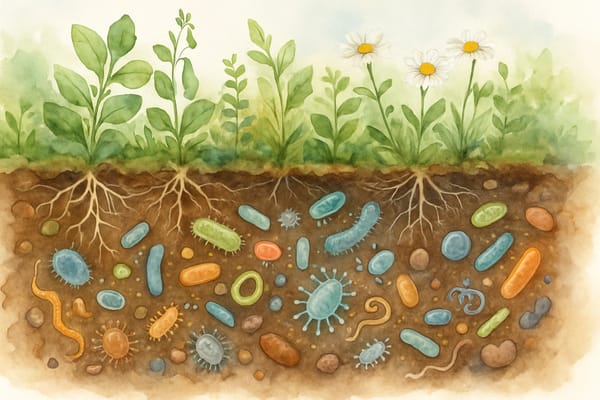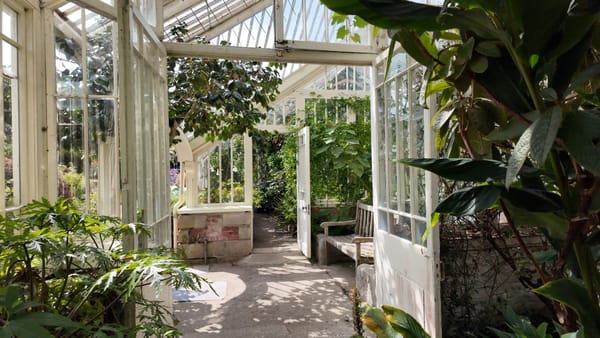Beneath the surface of every thriving Cornish garden lies a world we rarely see—yet one that underpins everything we grow. From the lush veg patches of the Roseland to the sheltered flower beds of Fowey, the true workhorses of soil health are not always roots, worms, or fungi. They are the tiniest of life forms: bacteria and archaea.
While mycelium has captured the imagination of many, it’s only part of the picture. Garden soil is teeming with an extraordinary community of microscopic organisms, each performing vital, unseen roles in keeping our plants healthy, resilient, and nourished. This quiet microbial engine—buzzing with billions of invisible lives in every teaspoon of earth—is the reason our gardens can flourish.
So today, we take a closer look at the lesser-known allies underfoot: the microbes that build fertility, defend against disease, and help our gardens adapt in a changing climate.
The Benevolent Bacteria of the Garden Soil
In Cornwall, where the climate is mild and moist for much of the year, bacteria thrive. These single-celled organisms form one of the most diverse and active components of the soil microbiome, and their roles are nothing short of remarkable.
The most crucial of these is nutrient cycling. As organic matter—leaf litter, compost, decaying roots—breaks down, it’s bacteria that make those nutrients available to plants. They transform complex compounds into simpler forms, especially nitrogen, phosphorus, and sulfur, which are essential for plant growth.
Among the stars of this system are Rhizobium and Azotobacter, two genera of bacteria that play a key role in nitrogen fixation. While Rhizobium lives symbiotically in root nodules on legumes like peas, beans, and clover, Azotobacter floats freely through the soil, quietly converting atmospheric nitrogen into forms plants can absorb.
For gardeners, this means that growing legumes doesn’t just yield a crop—it improves the fertility of the soil itself.
Plant Defenders and Soil Doctors
Bacteria don’t just feed plants—they help protect them too.
Certain beneficial bacteria, such as Bacillus and Pseudomonas, compete with harmful microbes by outnumbering them or producing natural antibiotics. This disease suppression means that soil with a healthy microbial balance is better able to defend itself—no sprays required.
Even more impressively, some of these bacteria “talk” to the plants they surround, triggering immune responses that help the plant prepare for pests and pathogens before an attack even begins. Think of it as early warning through a microbial whisper network.
This defence mechanism isn’t theoretical—it’s being demonstrated in trials across the UK. RHS research has highlighted how certain composts and teas foster populations of these helpful organisms, and even simple cover crops like rocket or mustard can support them.
Meet the Archaea: Quiet Resilience Builders
If bacteria are the bustling workforce of the soil, then archaea are its survivalists.
Less well known and only recently studied in detail, these microorganisms are especially important under extreme or fluctuating conditions. In Cornwall’s wetter winters and increasingly unpredictable summers, this matters more than ever.
Some archaea participate in nitrification, helping convert ammonia into plant-available nitrate. Others are involved in methane and nitrogen gas cycling, subtly influencing how much greenhouse gas a patch of soil releases—or retains.
Their resilience makes them especially valuable in waterlogged, compacted, or drought-affected soils. In short, they help maintain microbial stability when the going gets tough.
Why Diversity Matters: The Insurance Policy of Soil Health
Cornish gardens may differ wildly in style—from wildflower-rich plots by the coast to vegetable terraces tucked into steep hillsides—but they all benefit from one key principle: diversity begets resilience.
The broader the microbial community, the more functions it can perform, and the better it can adapt. This means that even if one species is disrupted—by drought, digging, or a sudden cold snap—others can step in. It’s nature’s way of building redundancy into the system.
Studies from Rothamsted and UK organic research projects show that gardens with high microbial diversity have lower levels of nitrous oxide emissions (a potent greenhouse gas), more stable nitrogen levels, and greater resistance to pests and diseases. The microbial ecosystem buffers the soil—and by extension, the plants—from external shocks.
What This Looks Like in a Cornish Garden
If you’ve walked through a mature Cornish border after rain and caught the deep, “earthy” scent of healthy soil, you’ve met the handiwork of actinobacteria—the same group that produces the compound geosmin, responsible for that distinctive smell.
In gardens where digging is minimal, compost is rich, and living roots are left year-round, microbial life thrives. Add to that Cornwall’s long growing season and relatively gentle winters, and you have an ideal climate for microbial richness.
From inland smallholdings to wind-swept coastal plots, gardeners who mulch with leaf mould, grow legumes, and rotate crops help foster a vibrant microbiome. It’s not about doing everything—but about creating an environment where invisible partnerships can quietly bloom.
Caring for the Soil Microbiome: Practical Steps
Even small changes can dramatically improve microbial health. Here are ways you can nurture this community:
- Feed the soil with organic matter: Compost, well-rotted manure, leaf mould, and mulch feed microbes as well as plants.
- Avoid deep digging: No-dig beds preserve delicate microbial layers and networks.
- Grow a variety of plants: Different root systems support different microbes.
- Let roots live year-round: Living mulches or cover crops keep microbial populations active.
- Minimise chemical disruption: Pesticides and high-salt fertilisers can wipe out beneficial organisms.
- Pay attention to scent and structure: Healthy soil smells earthy and feels crumbly, not sticky or dry.
New tools like DNA-based soil testing kits are becoming available for home growers too. These can reveal the microbial richness of your garden and track changes over time—ideal for community plots, school gardens, or those just curious to see what’s living under their boots.
The Microbial Future of Soil Stewardship
Just as we’re learning to appreciate fungi as ecological allies, it’s time to extend that respect to the bacteria and archaea that form the foundation of soil life. These microscopic partners don’t ask much: a little care, a little compost, and a home that isn’t constantly disturbed.
By welcoming them, we not only grow stronger, more resilient gardens—but begin to restore the balance between human cultivation and the unseen ecosystems that make it possible.
In Cornwall, with its deep horticultural traditions and abundant natural beauty, the stage is set. Gardeners here have the opportunity to model a way of growing that’s informed by the science of the soil—and by an abiding respect for what lies beneath.
Takeaway Actions for Cornwall’s Gardeners
- Grow legumes like peas, beans, and clover to support nitrogen-fixing bacteria.
- Use leaf litter and mulch as a microbial food source—not just as ground cover.
- Rotate crops and avoid compaction to keep microbial communities balanced.
- Try a microbe “smell test” after rain—healthy soil will smell rich and pleasant.
- Be curious: monitor your soil with simple tests or explore DNA kits to track your garden’s microbial story.








